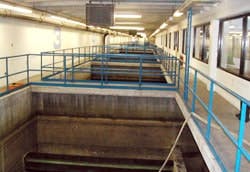UF Membranes Upgrade Capacity and Quality at Colorado WTP
Boosting water production and increasing water quality is a major challenge for municipalities that are equipped with aging or under-performing water treatment plants and have little or no ability to increase treatment capacity.
Retrofitting existing water treatment plants with advanced membrane ultrafiltration (UF) technology is one way for water managers to extend the life of existing buildings and minimize the capital costs of expanding. This strategy can also enable a plant to significantly improve treated water quality, while doubling or even tripling plant output with little or no expansion of the plant footprint.
Water quality was a major concern for the city of Thornton, which recently retrofitted its 30-year old, dual-media gravity filtration WTP with ZENON ZeeWeed immersed UF membranes.
The city worked with engineering firm Burns & McDonnell to evaluate products from three membrane companies, and at the conclusion, selected ZeeWeed for the retrofit based on the present worth cost evaluation, high value, and outstanding performance.
Drawing water from the South Platte River and Clear Creek, the city's Columbine WTP faces many challenges in treating the water.
With 10 to 15 wastewater treatment plants upriver, nitrates, total dissolved solids (TDS), and hardness are quite high by the time the water reaches the intake pipes of the Columbine WTP. In fact, at various times throughout the year, treated wastewater effluent can comprise up to 70% of the water flowing past Thornton.
"Given the high degree of wastewater effluent in our source water, we knew that we needed an advanced treatment process such as ultrafiltration membranes to ensure that we could provide the best quality water for the city," said Frank Watt, Water Treatment Plant Supervisor for the City of Thornton.
Tight timeline to complete retrofit
The city of Thornton shut down its Columbine WTP in October 2004, and Garney Construction began work on the retrofit. During the retrofit, the city's second WTP would provide an adequate supply of water throughout the winter months, but work would have to proceed quickly in order for the plant to re-open in March 2005 and be fully prepared to meet peak summer demand.
The retrofit process included removing the plant's granular filter media, modifying piping to accommodate the membrane system and increased flow parameters, and installing pumps and blowers for permeate production, backpulse cleaning and aeration. The upgrade also added a new three million gallon clear well, a 60-MGD high service pump station, a chemical building, a maintenance building, and administrative office.
Membranes expand capacity to 50 MGD
Water from the South Platte River and Clear Creek is collected in a string of gravel lakes prior to reaching the treatment plant. The raw water is pumped from the lakes and pretreated by coagulation, flocculation, and sedimentation through four upflow solids clarifiers from the old conventional plant. From the clarifiers the water flows to the ZeeWeed process tanks, where seven trains of ZeeWeed membranes provide ultrafiltration for up to 50 MGD of water.
Thousands of membrane fibers hang loosely in each membrane cassette and a slight vacuum is applied to the end of each membrane fiber to draw water through microscopic pores and into the hollow fibers. With a nominal pore size of 0.04 m, the membranes form a physical barrier to suspended solids and provide greater than 4-log removal of pathogens such as Giardia and Cryptosporidium, and turbidity of less than 0.1 NTU. Rejected particles remain in the process tank and are discharged to reject equalization tanks. From these tanks, reject transfer pumps feed the water to the second stage filtration train.
The second stage, 2.1-MGD train enhances the recovery of potable water from the river and is made up of five ZeeWeed cassettes. The configuration enables the plant to recover more than 99 percent of potable water from the river and also substantially reduces the cost of raw water pumping.
Planning for the future
Provisions have been made at the Columbine WTP to accommodate a ZENON reverse osmosis (RO) system to treat up to 15 MGD of permeate to further reduce total dissolved solids (TDS) and nitrates. Although the incoming raw water can experience turbidity variations that range from 1.5 to 40 NTU, the ZeeWeed membranes will consistently provide the RO system with high quality feed water with an SDI of less than one. Seven trains of RO membranes will enable this future system to produce pure water that will be blended with the ZeeWeed permeate to further enhance the quality of the water that is sent to the city.
"We anticipate that the new Columbine WTP will help meet both our water quantity and quality requirements for the next 50 years," Watt said. "As the EPA and the state of Colorado continue to set higher water quality standards, we believe that our ZeeWeed membrane system will enable us to continue to meet today's standards as well as any future requirements."
Mark A. Lichtwardt, P.E., is a project Engineer for Burns & McDonnell, he can be reached at [email protected]. Ronald Maness is a regional sales manager, for ZENON Environmental Inc., he can be reached at [email protected] . Drew Goodyear is president of the Water Technology Group, he can be reached at [email protected].
